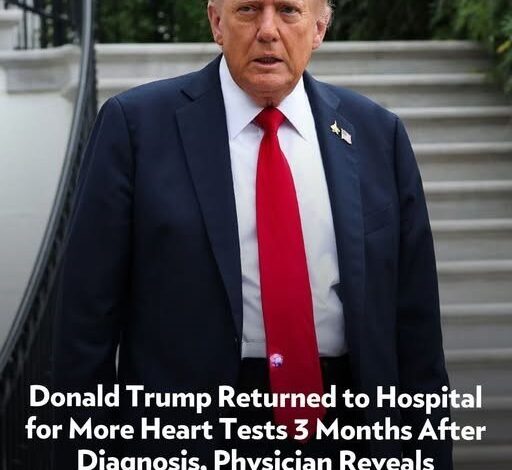
Donald Trump Returned to Hospital for More Heart Tests 3 Months After Diagnosis, Physician Reveals
Former President Donald Trump, 79, returned to Walter Reed National Military Medical Center on October 10, 2025, for additional cardiovascular testing — just three months after being diagnosed with chronic venous insufficiency (CVI), a circulatory condition common in older adults. The visit, according to the White House physician Dr. Sean Barbabella, was part of Trump’s ongoing preventive health regimen, not an emergency admission.
Despite online speculation, Dr. Barbabella clarified that the visit was routine and included a series of advanced heart screenings, laboratory work, and imaging procedures. “President Trump’s results were exceptional,” he reported, adding that the former president’s cardiac age is approximately 14 years younger than his chronological age. In medical terms, that means his cardiovascular system is performing like that of a healthy 65-year-old.
The physician emphasized that Trump continues to demonstrate “strong cardiac, pulmonary, neurological, and physical performance,” maintaining a busy daily schedule without limitations. During this latest evaluation, Trump also received updated influenza and COVID-19 vaccinations as part of his preventative care plan.
A Follow-Up to an Earlier Diagnosis
The follow-up visit came three months after Trump’s July 2025 appointment, when mild swelling in his lower legs prompted doctors to conduct further vascular studies. Those tests led to a diagnosis of chronic venous insufficiency, a condition in which blood flow from the legs back to the heart becomes sluggish due to weakened valves in the veins. While CVI can cause discomfort or swelling, it is not considered life-threatening when properly managed.
Dr. Barbabella reassured the public that the condition is under control and poses no risk to the former president’s ability to serve. “President Trump’s venous insufficiency is being effectively managed through lifestyle adjustments and monitoring. His overall health remains excellent,” he stated.
According to sources close to the medical team, Trump’s doctors recommended light cardiovascular exercises, compression therapy, and occasional checkups to monitor circulation — standard practices for older adults managing similar vascular issues.
Transparent but Watched Closely
Trump’s health remains one of the most closely monitored topics in U.S. politics. As the oldest individual ever elected to the presidency, every medical update carries significant public and media interest. His team, aware of past controversies over presidential health disclosures, has made a visible effort to maintain transparency.
This latest examination follows a series of comprehensive physicals conducted earlier in 2025, during which Trump was declared “fully fit to serve.” The April 2025 report, which involved 14 medical specialists, covered everything from cardiac imaging and neurological testing to metabolic and mood screenings. At the time, results showed improved cholesterol levels, stable blood pressure, a 25-pound weight loss, and no evidence of cognitive impairment.
Still, Trump’s advanced age continues to fuel public scrutiny. Political strategists and analysts often point to subtle physical details — such as slower movements, minor speech slips, or visible bruising — as signs of aging. White House officials, however, have dismissed such claims as exaggerated. Dr. Barbabella specifically addressed the bruising sometimes seen on Trump’s hands, explaining that it is “consistent with frequent handshaking and daily low-dose aspirin use,” both common in individuals of his age and activity level.
Lifestyle and Workload
Those who work closely with Trump describe him as energetic and highly engaged, often maintaining a schedule that would challenge someone decades younger. He reportedly wakes before dawn, reviews policy briefings, and participates in meetings well into the evening. His aides say he remains deeply involved in political strategy, media planning, and party outreach.
While critics have questioned whether such a high-demand lifestyle could be sustainable for a man approaching 80, Trump’s physician insists his stamina is “remarkable.” The former president reportedly adheres to a low-fat, low-cholesterol diet, though insiders admit he still enjoys fast food on occasion — a long-standing preference from his first term.
Trump’s weight loss over the past year, believed to have been achieved through stricter meal planning and light physical training, has reportedly improved his cardiovascular function and reduced stress on his circulatory system.
Political Context and Public Reaction
Trump’s hospital visit comes at a politically sensitive moment. With the 2026 midterm elections approaching and speculation mounting about his long-term plans, questions about his health have resurfaced across media platforms.
Supporters quickly rallied around the former president, sharing clips and photos from recent public events to highlight his energy. “He’s healthier and sharper than most men half his age,” one supporter wrote on social media. Others criticized the media for “fueling unnecessary panic” about what appears to be a standard medical checkup.
Opponents, meanwhile, used the occasion to reignite concerns about age and presidential fitness, an issue that has loomed large over both major parties in recent years. Political commentators noted that while Trump’s medical updates have been relatively transparent compared to his earlier years in office, skepticism remains high among voters who demand full disclosure about the health of senior political figures.
The Bigger Picture: Aging Leaders and Modern Medicine
Trump’s case is emblematic of a broader discussion about longevity and leadership. Advances in medical science and preventive care now allow individuals well into their 70s and 80s to remain active, mentally sharp, and physically capable. Cardiologists note that with the right combination of exercise, medication, and diet, cardiovascular performance can remain strong deep into old age.
Dr. Barbabella’s remarks echoed that sentiment: “President Trump’s results show the impact of consistent monitoring and lifestyle management. Age alone is not an indicator of health. Functionality, endurance, and medical data tell a more accurate story.”
Still, some health experts caution that chronic venous insufficiency, while manageable, should not be dismissed entirely. It requires ongoing monitoring to prevent complications such as blood clots or ulcers. For someone with Trump’s travel-heavy and high-stress routine, doctors say vigilance will be key.
Looking Ahead
As of now, there are no restrictions on Trump’s schedule. His team confirmed that he will continue participating in public appearances and policy meetings. According to aides, the former president was “in good spirits” following his hospital visit and returned immediately to his Washington residence.
In a brief statement, Trump himself thanked supporters for their concern but downplayed the visit. “Just a standard check-up — feeling strong, working hard, and moving forward,” he said in a post shared on his social media platform, Truth Social.
Whether viewed as a health precaution or a political necessity, Trump’s return to Walter Reed underscores the careful balance between age, leadership, and transparency in modern politics. At nearly 80, he remains both a symbol of resilience and a reminder of the realities of human aging, even for those accustomed to living in the spotlight.
And if the latest medical reports are accurate, Trump’s heart — figuratively and literally — still seems to be holding steady under the pressure.




